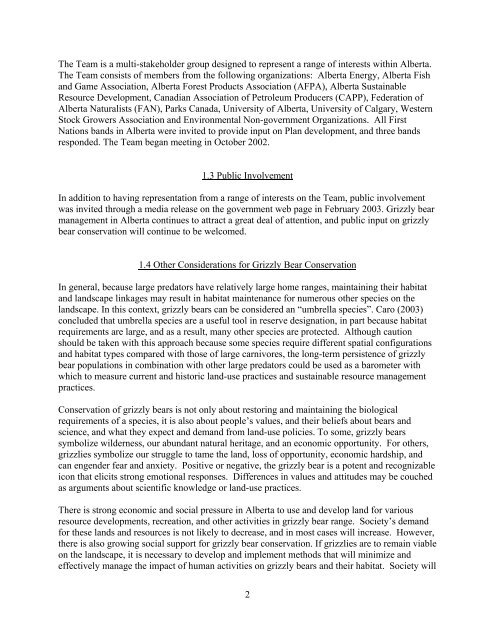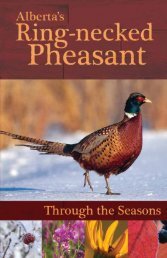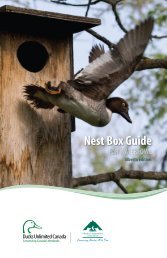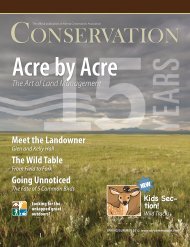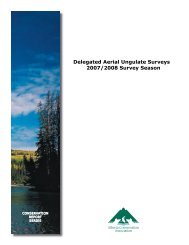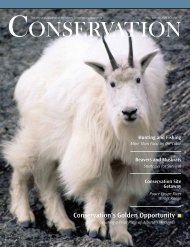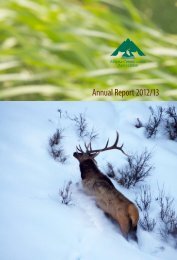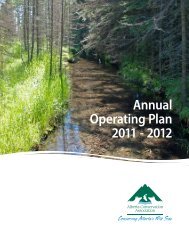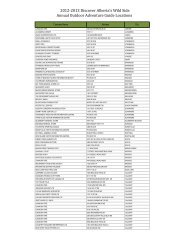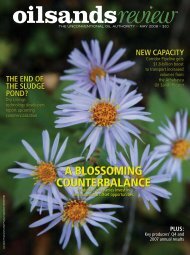Alberta Grizzly Bear Recovery Plan 2008-2013 - Alberta Sustainable ...
Alberta Grizzly Bear Recovery Plan 2008-2013 - Alberta Sustainable ...
Alberta Grizzly Bear Recovery Plan 2008-2013 - Alberta Sustainable ...
You also want an ePaper? Increase the reach of your titles
YUMPU automatically turns print PDFs into web optimized ePapers that Google loves.
The Team is a multi-stakeholder group designed to represent a range of interests within <strong>Alberta</strong>.<br />
The Team consists of members from the following organizations: <strong>Alberta</strong> Energy, <strong>Alberta</strong> Fish<br />
and Game Association, <strong>Alberta</strong> Forest Products Association (AFPA), <strong>Alberta</strong> <strong>Sustainable</strong><br />
Resource Development, Canadian Association of Petroleum Producers (CAPP), Federation of<br />
<strong>Alberta</strong> Naturalists (FAN), Parks Canada, University of <strong>Alberta</strong>, University of Calgary, Western<br />
Stock Growers Association and Environmental Non-government Organizations. All First<br />
Nations bands in <strong>Alberta</strong> were invited to provide input on <strong>Plan</strong> development, and three bands<br />
responded. The Team began meeting in October 2002.<br />
1.3 Public Involvement<br />
In addition to having representation from a range of interests on the Team, public involvement<br />
was invited through a media release on the government web page in February 2003. <strong>Grizzly</strong> bear<br />
management in <strong>Alberta</strong> continues to attract a great deal of attention, and public input on grizzly<br />
bear conservation will continue to be welcomed.<br />
1.4 Other Considerations for <strong>Grizzly</strong> <strong>Bear</strong> Conservation<br />
In general, because large predators have relatively large home ranges, maintaining their habitat<br />
and landscape linkages may result in habitat maintenance for numerous other species on the<br />
landscape. In this context, grizzly bears can be considered an “umbrella species”. Caro (2003)<br />
concluded that umbrella species are a useful tool in reserve designation, in part because habitat<br />
requirements are large, and as a result, many other species are protected. Although caution<br />
should be taken with this approach because some species require different spatial configurations<br />
and habitat types compared with those of large carnivores, the long-term persistence of grizzly<br />
bear populations in combination with other large predators could be used as a barometer with<br />
which to measure current and historic land-use practices and sustainable resource management<br />
practices.<br />
Conservation of grizzly bears is not only about restoring and maintaining the biological<br />
requirements of a species, it is also about people’s values, and their beliefs about bears and<br />
science, and what they expect and demand from land-use policies. To some, grizzly bears<br />
symbolize wilderness, our abundant natural heritage, and an economic opportunity. For others,<br />
grizzlies symbolize our struggle to tame the land, loss of opportunity, economic hardship, and<br />
can engender fear and anxiety. Positive or negative, the grizzly bear is a potent and recognizable<br />
icon that elicits strong emotional responses. Differences in values and attitudes may be couched<br />
as arguments about scientific knowledge or land-use practices.<br />
There is strong economic and social pressure in <strong>Alberta</strong> to use and develop land for various<br />
resource developments, recreation, and other activities in grizzly bear range. Society’s demand<br />
for these lands and resources is not likely to decrease, and in most cases will increase. However,<br />
there is also growing social support for grizzly bear conservation. If grizzlies are to remain viable<br />
on the landscape, it is necessary to develop and implement methods that will minimize and<br />
effectively manage the impact of human activities on grizzly bears and their habitat. Society will<br />
2


